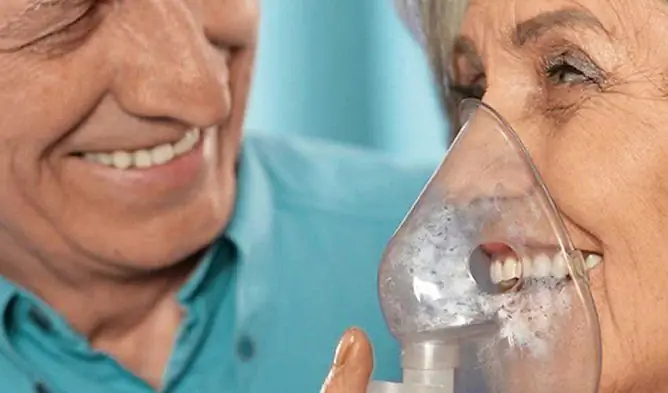- Author Rachel Wainwright [email protected].
- Public 2023-12-15 07:39.
- Last modified 2025-11-02 20:14.
Atrovent
Atrovent: instructions for use and reviews
- 1. Release form and composition
- 2. Pharmacological properties
- 3. Indications for use
- 4. Contraindications
- 5. Method of application and dosage
- 6. Side effects
- 7. Overdose
- 8. Special instructions
- 9. Application during pregnancy and lactation
- 10. Use in childhood
- 11. In case of impaired renal function
- 12. Drug interactions
- 13. Analogs
- 14. Terms and conditions of storage
- 15. Terms of dispensing from pharmacies
- 16. Reviews
- 17. Price in pharmacies
Latin name: Atrovent
ATX code: R03BB01
Active ingredient: ipratropium bromide (ipratropium bromide)
Producer: Instituto De Angeli (Italy)
Description and photo update: 2019-09-09
Prices in pharmacies: from 198 rubles.
Buy

Atrovent is a synthetic drug used to prevent bronchospasm in bronchial asthma.
Release form and composition
The drug is produced in the form of a colorless solution for inhalation (in glass dropper bottles of 20 ml, in a cardboard box 1 bottle and instructions for use of Atrovent).
1 ml of Atrovent contains:
- Active ingredient: anhydrous ipratropium bromide - 250 mcg;
- Excipients: disodium edetate dihydrate, benzalkonium chloride, hydrochloric acid, sodium chloride, purified water.
Pharmacological properties
Pharmacodynamics
Ipratropium bromide is a bronchodilator that blocks m-cholinergic receptors of the smooth muscles of the tracheobronchial tree and suppresses reflex bronchoconstriction. The substance has a structural similarity to the acetylcholine molecule and is one of its competitive antagonists.
Anticholinergics help prevent an increase in the intracellular concentration of calcium ions. This is due to the interaction of muscarinic receptors located in the smooth muscles of the bronchi with acetylcholine.
The release of calcium ions occurs with the help of mediators, which include ITP and DAG (inositol triphosphate and diacylglycerol).
Ipratropium bromide effectively prevents the development of bronchospasm due to inhalation of cold air, cigarette smoke, exposure to various drugs, and also relieves bronchospasm caused by the influence of the vagus nerve. There is practically no resorptive effect with inhalation. Bronchodilation that occurs after inhalation is mainly a consequence of the specific and local effect of the drug on the lungs, and not the result of its systemic exposure. Ipratropium bromide has no negative effect on mucus secretion in the respiratory tract, gas exchange and mucociliary clearance does not.
When conducting controlled studies in patients with bronchospasm caused by chronic obstructive pulmonary disease, emphysema and chronic bronchitis, it was found that a significant improvement in lung function is noted within 15 minutes, reaches a maximum after 60-120 minutes and lasts for 4-6 hours.
Pharmacokinetics
The therapeutic effect of ipratropium bromide is a consequence of its local action in the respiratory tract. The development of bronchodilation with pharmacokinetic parameters is not parallel.
After inhalation, from 10 to 30% of the administered dose of the substance enters the lungs (depending on the dosage form and method of inhalation). Most of the ipratropium bromide is swallowed and enters the gastrointestinal tract. Part of the dose after entering the lungs quickly (in a few minutes) reaches the systemic circulation.
The total renal excretion of the parent compound (within 24 hours) is approximately 46% of the dose administered intravenously, with oral administration - <1% of the dose, with inhalation use - from 3 to 13%. The estimated total systemic bioavailability of ipratropium bromide, administered orally and inhaled, is 2% and 7-28%, respectively, ie the ingested part of the substance has little effect on systemic exposure.
Ipratropium bromide binds to plasma proteins at a minimal level (up to 20%).
The kinetic parameters that describe the distribution of ipratropium bromide were calculated based on its plasma concentration after intravenous administration. There is a rapid biphasic decrease in plasma concentration. The apparent V d (volume of distribution) at equilibrium is approximately 176 l (2.4 l / kg).
Ipratropium bromide is a quaternary ammonium compound that does not penetrate the placental and blood-brain barriers.
After intravenous administration, about 60% of the dose is metabolized by oxidation, mainly in the liver.
The known metabolites, which are formed by dehydration, hydrolysis or separation of the hydroxymethyl group from tropic acid and are excreted in the urine, bind weakly to muscarinic receptors and are considered inactive.
T 1/2 (half-life) in the terminal phase is about 1.6 hours. The total clearance of ipratropium bromide is 2.3 ml / min, and the renal clearance is 0.9 L / min. The total renal excretion (over 6 days) of the isotope-labeled dose (including the parent compound and all its metabolites) after intravenous, oral and inhalation administration is 72.1%, 9.3% and 3.2%, respectively. The total isotope-labeled dose that is excreted through the intestine after intravenous, oral and inhalation administration is 6.3%, 88.5% and 69.4%, respectively. T 1/2 of the original compound and its metabolites - 3.6 hours.
Indications for use
- Bronchial asthma of moderate and mild severity;
- Chronic obstructive pulmonary disease, including emphysema and chronic obstructive bronchitis.
Contraindications
The use of Atrovent for inhalation is contraindicated in case of hypersensitivity to its components.
The drug should be used with caution:
- Hyperplasia of the prostate;
- Obstruction of the urinary tract;
- Closed-angle glaucoma;
- Children under 6 years old.
The first trimester of pregnancy is a contraindication to the use of Atrovent. In the II and III trimesters of pregnancy, as well as during breastfeeding, the appointment of the drug is possible only on strict indications.
Atrovent, instructions for use: method and dosage
The dosage regimen of Atrovent for inhalation is selected individually.
Children from 12 years old and adults are usually prescribed 3-4 inhalations per day, 2 ml each, which corresponds to 40 drops, maximum 8 ml.
The daily dose of Atrovent inhalation solution for children depends on age:
- Up to 6 years old - 10-20 drops 3-4 inhalations per day;
- From 6 to 12 years old - 20 drops up to 4 times a day.
The use of Atrovent in pediatrics is carried out only under medical supervision.
The required dose of the solution for inhalation immediately before the procedure should be diluted with saline to a volume of 3-4 ml. The solution remaining after the procedure cannot be reused. Aerosol is prescribed up to 4 times a day, two doses, but not more than 12 inhalations per day.
It is important to be careful while using Atrovent with tricyclic antidepressants, beta2-adrenomimetics, antiparkinsonian drugs, xanthine derivatives, quinidine and other anticholinergic drugs.
Side effects
Atrovent most commonly causes dry mouth, headache, and gastrointestinal motility disorders.
In addition, the drug can cause the following manifestations:
- Supraventricular tachycardia, increased heart rate, impaired accommodation, atrial fibrillation, palpitations, urinary retention;
- Local irritation and cough, less often - paradoxical bronchospasm;
- Dilation of the pupil and increased intraocular pressure (when the solution enters the eyes);
- Skin rash, laryngospasm, urticaria, itching, swelling of the tongue and face, Quincke's edema, anaphylactic reactions.
Overdose
No specific symptoms of an overdose have been identified. Given the breadth of the therapeutic effect and the local route of administration of Atrovent, the development of any serious anticholinergic symptoms is unlikely.
Possible symptoms: a slight manifestation of systemic anticholinergic effects (in the form of dry mouth, blurred vision, increased heart rate).
Therapy: symptomatic.
special instructions
It is not recommended to prescribe Atrovent for emergency relief of attacks of bronchial asthma, since the bronchodilator effect develops more slowly than when using beta-adrenergic agonists.
With cystic fibrosis, the risk of developing inhibition of gastrointestinal motility increases.
A significant excess of the recommended doses is contraindicated not only in the case of acute bronchospasm treatment, but also in maintenance therapy. In case of insufficient effectiveness of inhalations or worsening of the condition, the attending physician should change the treatment plan.
Atrovent is allowed to be used in combined inhalations simultaneously with such solutions for inhalation as Ambroxol, Bromhexin and Berotek.
The content of the antibacterial preservative benzalkonium chloride and the stabilizer disodium edetate in the preparation increase the risk of developing bronchospasm due to narrowing of the bronchial lumen.
Avoid contact with the eyes, especially in patients with a predisposition to glaucoma.
The doctor who prescribes Atrovent should teach the patient the rules for its use, and when using a nebulizer with a mask, help with the selection of a mask of a suitable size.
Influence on the ability to drive vehicles and complex mechanisms
Due to the likelihood of the development of tremor, dizziness, impaired accommodation of the eyes, blurred vision and mydriasis, patients should be careful when driving vehicles or completely abandon potentially dangerous actions.
Application during pregnancy and lactation
The safety profile of Atrovent during pregnancy has not been studied. For pregnant women in the first trimester, the drug is contraindicated, in the second and third trimesters, the doctor, if necessary, can decide on the appointment of Atrovent, provided that the intended benefit to the mother outweighs the possible risk to the fetus.
When conducting preclinical studies, the embryotoxic / teratogenic effect of the drug after its inhalation use in doses that significantly exceed the recommended ones was not revealed.
There are no clinical data to support or refute the effect of ipratropium bromide on fertility. A negative effect during the use of Atrovent in preclinical studies on fertility was not found.
During lactation, the use of Atrovent is possible only under strict indications.
Pediatric use
Caution is required when treating patients under 6 years of age.
With impaired renal function
In obstruction of the urinary tract, Atrovent is prescribed with caution.
Drug interactions
- Other anticholinergic drugs (long-term combination therapy): the combination is not recommended, due to the lack of data confirming the safety of simultaneous use;
- β-adrenomimetics (use with a nebulizer in patients with a history of close-angle glaucoma): the risk of acute glaucoma increases;
- Xanthine derivatives, β-adrenergic drugs: bronchodilator effect of Atrovent is enhanced;
- Antiparkinsonian drugs, quinidine, tricyclic antidepressants: anticholinergic effect increases;
- Cromoglycic acid (inhalation solution): the combination is not recommended due to the possibility of precipitation.
Analogs
Analogues of Atrovent are: Ipravent metered aerosol for inhalation, Atrovent N metered aerosol for inhalation, Ipratropium Steri-Neb solution for inhalation.
Drugs that are similar in the mechanism of action of one pharmaceutical subgroup: Spiriva, Troventola, Truvent, Sibri Breezhaler.
Terms and conditions of storage
Store at temperatures up to 30 ° C, out of the reach of children.
The shelf life is 3 years.
Terms of dispensing from pharmacies
Dispensed by prescription.
Reviews about Atrovent
Reviews of Atrovent in most cases characterize the drug as highly effective and easy to use. Indicate that, in comparison with analogues, the tool has a lower cost and better tolerance. Some users note that in severe bronchial asthma, the therapeutic effect may be insufficient.
Price for Atrovent in pharmacies
The approximate price for Atrovent (1 dropper bottle of 20 ml) is 223-241 rubles.
Atrovent: prices in online pharmacies
|
Drug name Price Pharmacy |
|
Atrovent 0.25 mg / ml solution for inhalation 20 ml 1 pc. 198 RUB Buy |
|
Atrovent N 20 μg / dose 200 doses aerosol for inhalation, dosed 10 ml 1 pc. 225 RUB Buy |
|
Atrovent solution for ing 0.25mg / ml 20ml 238 r Buy |
|
Atrovent N aerosol for in. dosage. 20mkg / dose 200 doses 10ml 327 r Buy |

Maria Kulkes Medical journalist About the author
Education: First Moscow State Medical University named after I. M. Sechenov, specialty "General Medicine".
Information about the drug is generalized, provided for informational purposes only and does not replace the official instructions. Self-medication is hazardous to health!






